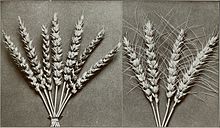Marquis wheat: Difference between revisions
dash Tags: Mobile edit Mobile web edit Advanced mobile edit |
Rescued dead link via archive.org and expanded the article. |
||
| Line 7: | Line 7: | ||
| cultivar = {{'}}'''Marquis'''{{'}} |
| cultivar = {{'}}'''Marquis'''{{'}} |
||
}} |
}} |
||
The {{'}}'''Marquis'''{{'}} [[bread wheat]] [[cultivar]] was developed by |
The {{'}}'''Marquis'''{{'}} [[bread wheat]] [[cultivar]] was developed by a team led by Dr. William Saunders, Director, Dominion Experimental Farms, between 1892 and 1909. It is a cross between [[Red Fife wheat|Red Fife]] (male parent) and Hard Red Calcutta (female parent).<ref>{{Cite book |last=Symko |first=Stephan |url=http://www5.agr.gc.ca/resources/prod/doc/publications/marquis/wheat-ble_e.pdf |title=From a Single Seed |publisher=Research Branch, Agriculture and Agri-Food Canada |year=1999 |isbn=0-662-28145-4 |pages=31}}</ref> It was [[Selective breeding|selected]] for superiority in milling quality for bread flour over [[List of Canadian heritage wheat varieties|other cultivars then prevalent in western Canada]]. 'Marquis' had the advantage of maturing 10 days earlier than its competitors – a factor of great importance in the [[prairies|Canadian wheatbelt]] such as [[Alberta]], [[Manitoba]] and [[Saskatchewan]], extending as far south as southern [[Nebraska]].<ref>[http://www.thecanadianencyclopedia.ca/en/article/marquis-wheat/ thecanadianencyclopedia.ca: "Marquis Wheat"]</ref><ref>{{cite web |title=The Wheat That Won The West: The Impact of Marquis Wheat Development |url=https://wdm.ca/wp-content/uploads/2018/08/WDM-MarquisWheatPaper.pdf |archive-url=https://web.archive.org/web/20210621164311/https://wdm.ca/wp-content/uploads/2018/08/WDM-MarquisWheatPaper.pdf |archive-date=2021-06-21}}</ref><ref>{{cite web | author = Stephan Symko | title = From a single seed - Tracing the Marquis wheat success story in Canada to its roots in the Ukraine | url = https://www.iceagefarmer.com/docs/StephanSymko-FromaSingleSeed.pdf}}</ref> |
||
In 1892, Dr. William Saunders, and his team imported imported wheat varieties from Russia, India, Japan, Australia and the USA to be tested alongside Red Fife. Ultimately, it was the Red Fife cross with Hard Red Calcutta, from India, that gave rise to the Marquis wheat. "Hard Red Calcutta gave low yields and was of poor quality; however, the wheat matured roughly 20 days prior to Red Fife."<add ref> |
|||
In 1907, Dr. Charles Saunders, Dominion Cerealist (son of Dr. William Saunders), sent 23 pounds of Marquis wheat from Ottawa to the Indian Head Experimental Farm to test the grain under prairie conditions. The variety produced high yields and ripened early; and, although it wasn't rust resistant, it was ready for harvest before rust was became problematic. In 1909, four hundred samples were distributed to farmers throughout Western Canada, resulting in a number of successful crops grown. |
|||
By 1920, Marquis wheat accounted for 90 percent of the 6 hard red spring wheat planted on the Canadian prairies. The introduction of Marquis resulted in wheat production in Saskatchewan doubling between 1906 and 1920. |
|||
==Notes== |
==Notes== |
||
Revision as of 21:47, 29 June 2024
| Triticum aestivum 'Marquis' | |
|---|---|
 'Marquis' wheat (left) compared to 'Preston' (right) | |
| Species | Triticum aestivum |
| Cultivar | 'Marquis' |
The 'Marquis' bread wheat cultivar was developed by a team led by Dr. William Saunders, Director, Dominion Experimental Farms, between 1892 and 1909. It is a cross between Red Fife (male parent) and Hard Red Calcutta (female parent).[1] It was selected for superiority in milling quality for bread flour over other cultivars then prevalent in western Canada. 'Marquis' had the advantage of maturing 10 days earlier than its competitors – a factor of great importance in the Canadian wheatbelt such as Alberta, Manitoba and Saskatchewan, extending as far south as southern Nebraska.[2][3][4]
In 1892, Dr. William Saunders, and his team imported imported wheat varieties from Russia, India, Japan, Australia and the USA to be tested alongside Red Fife. Ultimately, it was the Red Fife cross with Hard Red Calcutta, from India, that gave rise to the Marquis wheat. "Hard Red Calcutta gave low yields and was of poor quality; however, the wheat matured roughly 20 days prior to Red Fife."<add ref>
In 1907, Dr. Charles Saunders, Dominion Cerealist (son of Dr. William Saunders), sent 23 pounds of Marquis wheat from Ottawa to the Indian Head Experimental Farm to test the grain under prairie conditions. The variety produced high yields and ripened early; and, although it wasn't rust resistant, it was ready for harvest before rust was became problematic. In 1909, four hundred samples were distributed to farmers throughout Western Canada, resulting in a number of successful crops grown.
By 1920, Marquis wheat accounted for 90 percent of the 6 hard red spring wheat planted on the Canadian prairies. The introduction of Marquis resulted in wheat production in Saskatchewan doubling between 1906 and 1920.
Notes
- ^ Symko, Stephan (1999). From a Single Seed (PDF). Research Branch, Agriculture and Agri-Food Canada. p. 31. ISBN 0-662-28145-4.
- ^ thecanadianencyclopedia.ca: "Marquis Wheat"
- ^ "The Wheat That Won The West: The Impact of Marquis Wheat Development" (PDF). Archived from the original (PDF) on 2021-06-21.
- ^ Stephan Symko. "From a single seed - Tracing the Marquis wheat success story in Canada to its roots in the Ukraine" (PDF).

